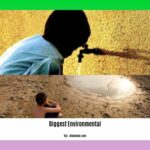In today’s world, our planet is facing an array of urgent environmental problems that demand our immediate attention. From the dire consequences of air pollution and deforestation to the alarming threat of soil degradation and biodiversity loss, these 15 major issues pose a significant risk to the health and sustainability of our planet. As we delve into the complexities of these pressing problems, it becomes clear that our collective action is needed now more than ever. Through this comprehensive guide, we will explore these critical challenges and gain a deeper understanding of their impact on our planet and the urgent need for effective solutions.
Key Takeaways:
- Pollution: Air, water, and soil pollution caused by toxins and pollutants is a major environmental problem.
- Global Warming: The increase in the global temperature of the Earth’s atmosphere is causing significant environmental issues.
- Overpopulation: Growing population puts pressure on natural resources and the environment.
- Waste Disposal: Improper waste disposal leads to contamination and the creation of landfills and dumps.
- Ocean Acidification: The reduction in ocean water pH due to human activities affects marine life.
- Loss of Biodiversity: The diminishing variety of life forms and ecosystems has serious consequences.
- Deforestation: The destruction of forests and habitats has far-reaching negative impacts.
- Ozone Layer Depletion: The thinning of the ozone layer exposes the Earth to harmful ultraviolet rays.
- Genetic Engineering: Altered natural traits through genetic engineering may have unforeseen consequences.
- Urban Sprawl: The expansion of urban areas encroaches on agricultural land and natural spaces.
- Soil Erosion: The diminishing fertility and quality of soil have adverse effects on agriculture.
- Desertification: Fertile land turning into arid and barren areas is a significant concern.
- Natural Disasters: Environmental damage and destruction caused by natural disasters affect both ecosystems and human lives.
- Nuclear Issues: The risks associated with radiation exposure and nuclear waste pose serious environmental concerns.
- Climate Change: Alterations in weather patterns and seasons have wide-ranging impacts on the planet.
Sources:
1. Environmental Problems Our World is Facing Right Now. (n.d.). Retrieved from source
2. Major Current Environmental Problems. (n.d.). Retrieved from source
15 Major Current Environmental Problems


Pollution: Threatening Our Air, Water, and Soil
Pollution is one of the most pressing environmental problems our planet faces today. Air pollution, caused by toxins and pollutants released from industries and vehicles, not only affects our health but also contributes to climate change. Water pollution poses a threat to aquatic ecosystems and the availability of clean drinking water. Meanwhile, soil pollution impacts the fertility and productivity of agricultural land, posing a risk to food security.
Global Warming: The Rising Temperature Crisis
Global warming, caused by the increase in the Earth’s atmospheric temperature, is another critical issue we must address urgently. This rise in temperature leads to climate change, with severe impacts such as extreme weather events, melting ice caps, and rising sea levels. The consequences are devastating for both humans and ecosystems, including increased droughts, heatwaves, and the disruption of delicate ecological balance.
Overpopulation: Straining Natural Resources
Our ever-growing population is putting immense pressure on natural resources and the environment. As more people inhabit the Earth, the demand for food, water, energy, and land increases. This strain leads to overexploitation, depletion of resources, and habitat destruction. It is crucial to find sustainable solutions to ensure a balanced and thriving planet for future generations.
Waste Disposal: Contaminating Our Environment
Improper waste disposal has become a significant concern globally. Landfills and dumps release harmful substances into the environment, contaminating soil, water, and air. Plastic waste, in particular, poses a grave threat to marine life, with tons of plastics ending up in our oceans every year. To combat this problem, reducing waste, recycling, and promoting eco-friendly alternatives are essential.
Ocean Acidification: Endangering Marine Life
Ocean acidification occurs when the pH of seawater decreases due to the absorption of excess carbon dioxide from the atmosphere. This change in acidity negatively affects marine organisms, particularly those with calcium carbonate shells, like corals and mollusks. The delicate balance of marine ecosystems is disturbed, leading to reduced biodiversity, damaged coral reefs, and jeopardized fisheries.
Loss of Biodiversity: Diminishing Life Forms and Ecosystems
The loss of biodiversity is a critical issue that affects the entire planet. When species go extinct or habitats are destroyed, the delicate web of life is disrupted. This loss not only eliminates unique life forms but also weakens ecosystem resilience and stability. Protecting biodiversity is crucial for the health of our ecosystems and the survival of countless species, including our own.
Deforestation: Destroying Forests and Habitats
Deforestation continues to be a significant environmental problem, particularly in regions like the Amazon rainforest. The clearing of forests for agriculture, logging, and urbanization not only leads to the loss of vital habitats but also contributes to climate change. Forests act as carbon sinks, absorbing greenhouse gases. Without them, the amount of carbon dioxide in the atmosphere increases, exacerbating the global warming crisis.
Ozone Layer Depletion: Exposing the Earth to Harmful Rays
The depletion of the ozone layer is a concerning issue caused by the release of ozone-depleting substances (ODS) such as chlorofluorocarbons (CFCs). The ozone layer protects the Earth from harmful ultraviolet (UV) rays, which can lead to increased cases of skin cancer, cataracts, and harm to marine life. International agreements, like the Montreal Protocol, have been instrumental in reducing ODS production and protecting the ozone layer.
Genetic Engineering: Risks and Unforeseen Consequences
The use of genetic engineering in agriculture and biotechnology raises concerns about unforeseen consequences. While this technology has the potential to revolutionize food production and medical treatments, there is a need for careful regulation and assessment of potential risks. Altering the genetic makeup of organisms may have unintended ecological and health impacts, highlighting the importance of thorough research and responsible application.
Urban Sprawl: Expanding Cities at a Cost
Urban sprawl occurs when cities expand rapidly, consuming agricultural land and natural habitats. This unchecked growth leads to the destruction of green spaces, increased congestion, and the loss of biodiversity. Implementing sustainable urban planning practices and investing in public transportation can help mitigate the negative impacts of urban sprawl while creating livable, eco-friendly cities.
Soil Erosion: Threatening Soil Fertility
Soil erosion is a significant challenge as it degrades soil quality, reduces fertility, and threatens agricultural productivity. Factors such as deforestation, improper land management, and climate change contribute to this problem. By implementing soil conservation techniques like terracing, cover cropping, and contour plowing, we can help mitigate erosion and preserve the health of our soils.
Desertification: Transforming Fertile Lands into Barren Wastelands
Desertification poses a severe threat to regions around the world, turning once fertile land into barren wastelands. This process, often exacerbated by unsustainable agricultural practices, deforestation, and climate change, leads to the loss of arable land, displacement of communities, and increased vulnerability to droughts. Restoration efforts, reforestation, and sustainable land management are vital to combat desertification.
Natural Disasters: Devastating Impacts on the Environment
Natural disasters such as hurricanes, earthquakes, floods, and wildfires have profound impacts on both the environment and human lives. These events can result in the destruction of ecosystems, loss of biodiversity, and displacement of communities. Preparing for natural disasters, strengthening infrastructure, and taking adaptive measures can help mitigate their devastating effects.
Nuclear Issues: Risks of Radiation and Waste
The nuclear industry presents concerns regarding the risk of radiation exposure and the safe disposal of nuclear waste. Nuclear accidents, such as Chernobyl and Fukushima, have highlighted the catastrophic consequences of mishandling nuclear materials. Strict safety regulations, responsible waste management, and advancements in renewable energy technologies are crucial in minimizing the risks associated with nuclear power.
Climate Change: Alarming Impacts on the Planet
Climate change encompasses a wide range of issues that affect natural systems and human well-being. Rising global temperatures, changing weather patterns, and melting glaciers contribute to severe consequences such as sea-level rise, increased frequency of extreme weather events, and disruption of ecosystems. Urgent action in reducing greenhouse gas emissions, transitioning to renewable energy sources, and adapting to these changes is imperative.
In conclusion, these 15 major environmental problems pose urgent threats to our planet. From pollution and climate change to deforestation and loss of biodiversity, it is crucial to address these issues with immediate action. By raising awareness, promoting sustainable practices, and advocating for environmental protection, we can work together to preserve our planet for future generations.
To discover 3 fascinating facts about condensation, click here.
Explore the wonders of hydroelectric energy by learning 3 interesting facts here.
Uncover 3 captivating facts about hydroelectric energy that will amaze you here.
To understand the 5 advantages of sea transport, click here.
15. Soil Degradation
Soil degradation, an urgent issue threatening our planet, is a major environmental problem that demands our attention. Our soil, a vital resource for food production and ecosystem health, is facing alarming degradation due to various factors. Let’s delve into the depths of this issue, understand its causes, and explore its consequences.
Causes of Soil Degradation
1. Erosion: Soil erosion occurs when the top layer of soil is washed away by water or blown away by wind, leaving behind bare and infertile land. This process is often intensified by unsustainable agricultural practices and deforestation.
2. Decline in Organic Matter: The continual removal of crops without replenishing organic matter leads to a decline in soil fertility. This reduction in organic matter disrupts crucial nutrient cycling processes and reduces soil’s ability to retain water.
3. Loss of Biodiversity: When soil ecosystems lose their diverse array of beneficial organisms, such as earthworms, bacteria, and fungi, their ability to maintain soil health and structure diminishes. Deforestation, intensive farming, and urbanization contribute to this loss of biodiversity.
4. Compaction: Human activities like heavy machinery use and constant traffic lead to soil compaction, which results in a decrease in soil porosity and a limited ability to absorb and store water.
5. Sealing: The process of urbanization, where natural land is converted to impervious surfaces such as roads and buildings, leads to soil sealing. This prevents water infiltration, disrupts natural drainage patterns, and contributes to flooding.
6. Contamination and Pollution: Soil can become contaminated through the deposition of toxic substances like heavy metals, pesticides, and industrial pollutants. These contaminants can harm soil organisms, disrupt nutrient cycling, and render soil unsuitable for agriculture.
7. Salinization: Salinization occurs when the salt concentration in the soil increases to levels that are harmful to plant growth. Overuse of irrigation water, coupled with poor drainage, can result in the accumulation of salts in the soil.
Consequences of Soil Degradation
Soil degradation has far-reaching consequences, affecting both the environment and human society. Here are some of the major impacts:
1. Reduced Fertility: Degraded soil loses its ability to support healthy plant growth, leading to decreased crop productivity and food shortages.
2. Erosion-Related Disasters: Soil erosion makes areas prone to landslides and floods, causing extensive damage to infrastructure and posing risks to human lives.
3. Desertification: Soil degradation can contribute to the spread of desert-like conditions, rendering formerly fertile land barren and unproductive.
4. Increased Pollution: As the quality of soil diminishes, the risk of pollutants seeping into groundwater and contaminating water sources rises.
5. Decline in Ecosystem Services: Degraded soil loses its capacity to provide important ecosystem services such as carbon sequestration, water purification, and habitat for diverse organisms.
6. Loss of Cultural Heritage: Soil degradation can result in the loss of traditional agricultural practices, indigenous knowledge, and cultural heritage associated with land use and farming.
Key Takeaways:
- Soil degradation is a pressing environmental problem that arises from erosion, organic matter decline, loss of biodiversity, compaction, sealing, contamination, pollution, and salinization.
- The consequences of soil degradation include reduced fertility, erosion-related disasters, desertification, increased pollution, decline in ecosystem services, and loss of cultural heritage.
- Sustainable agricultural practices, reforestation efforts, and proper land management can help mitigate the effects of soil degradation.
Sources:
1. Environmental Problems Our World is Facing Right Now. (n.d.). Retrieved from source
2. EOS Data Analytics: link
4. Biodiversity Loss
Biodiversity loss, also known as biological diversity loss, is a critical environmental problem that threatens the delicate balance of ecosystems and life on Earth. It refers to the decline in the variety and abundance of plant and animal species within a particular area or globally. To fully understand the urgent need to address this issue, we must delve into its causes, effects, and key facts.
Natural Biodiversity Loss: Seasonal Changes and Fluctuations
Biodiversity naturally fluctuates with the changing seasons. For example, the arrival of spring brings opportunities for feeding and breeding, leading to increased biodiversity in many areas. These fluctuations are normal and contribute to the overall health and functioning of ecosystems.
Human-driven Biodiversity Loss: Disturbances Caused by Human Activities
Unfortunately, human activities have become a major driver of biodiversity loss, causing significant disruptions to ecosystems. Activities such as deforestation, wetland filling, stream channeling, road construction, and urbanization have destroyed habitats and led to the loss of countless species. The consequences of these actions are far-reaching and demand attention.
Key Drivers of Biodiversity Loss:
- Climate Change: Rising temperatures, shifting precipitation patterns, and extreme weather events pose significant threats to biodiversity, with species struggling to adapt to rapidly changing conditions.
- Habitat Loss: The unsustainable use of land for activities such as agriculture, deforestation, and urbanization results in the destruction and fragmentation of natural habitats, leaving species without suitable homes.
- Pollution: Air, water, and soil pollution have destructive effects on biodiversity, disrupting ecosystems and threatening the survival of numerous species.
- Overexploitation: Overexploitation of natural resources, such as overfishing and illegal wildlife trade, depletes populations and puts species at risk of extinction.
- Invasive Alien Species: The introduction of non-native species into ecosystems can have severe impacts on native species, disrupting the delicate ecological balance that supports biodiversity.
Biodiversity Loss in the Global Economy
The global economy plays a significant role in exacerbating biodiversity loss. Increased transportation of goods and travel have facilitated the spread of invasive alien species across natural boundaries. Combined with climate change, habitat destruction, and pollution, these invasive species intensify the negative impacts on biodiversity.
Impact of Biodiversity Loss: Consequences Beyond Environmental Decline
The effects of biodiversity loss go far beyond environmental decline. It has substantial implications for the global economy and the very foundations of human existence. Essential ecosystem services, such as pollination, water purification, and climate regulation, are at risk as more species disappear.
Studies show that North America has already experienced a biodiversity decline of 33% since 1970, a sobering reminder of the urgency to act. Addressing biodiversity loss is crucial not only for the protection of ecosystems and species but also for safeguarding our economies and ensuring the well-being of future generations.
Key Takeaways:
- Biodiversity loss refers to the decrease in the variety and abundance of plant and animal species within an area or globally.
- It is caused by a combination of natural fluctuations and disturbances resulting from human activities.
- Key drivers of biodiversity loss include climate change, habitat loss, pollution, overexploitation, and invasive alien species.
- Biodiversity loss has severe consequences for the global economy and essential ecosystem services.
- By understanding the causes and effects of biodiversity loss, we can develop effective conservation strategies and promote sustainable practices.
Sources:
– Britannica: Biodiversity Loss
– World Economic Forum: What are the 5 key drivers of biodiversity loss, according to UNEP?
FAQ
Q1: What are the main causes and impacts of air pollution?
A1: The main causes of air pollution include emissions from vehicles, industrial activities, and the burning of fossil fuels. The impacts of air pollution are significant and can range from respiratory and cardiovascular diseases to damage to ecosystems and the depletion of the ozone layer.
Q2: How does deforestation affect the environment and biodiversity?
A2: Deforestation leads to the destruction of habitats, resulting in the loss of biodiversity. It also contributes to climate change by reducing the Earth’s capacity to absorb carbon dioxide. Additionally, deforestation affects the water cycle, soil quality, and disrupts the balance of ecosystems.
Q3: What are the major consequences of soil degradation?
A3: Soil degradation has several major consequences, including reduced fertility, increased erosion, decreased water-holding capacity, and loss of biodiversity. It can lead to landslides, desertification, and reduced agricultural productivity, posing a threat to global food production.
Q4: What are the factors contributing to biodiversity loss?
A4: Biodiversity loss is primarily driven by climate change, habitat loss, pollution, overexploitation of natural resources, and invasive alien species. These factors disrupt ecosystems, threaten species survival, and disturb the delicate balance of biodiversity.
Q5: How does biodiversity loss impact the global economy?
A5: Loss of biodiversity poses a fundamental risk to the global economy. It affects essential ecosystem services, such as pollination, water purification, and climate regulation, which are critical for agriculture, medicine, and overall human well-being. The economic consequences include increased costs for ecosystem restoration and declining industries reliant on natural resources.
- China II Review: Delicious Food & Speedy Service - April 17, 2025
- Understand Virginia’s Flag: History & Debate - April 17, 2025
- Explore Long Island’s Map: Unique Regions & Insights - April 17, 2025
















